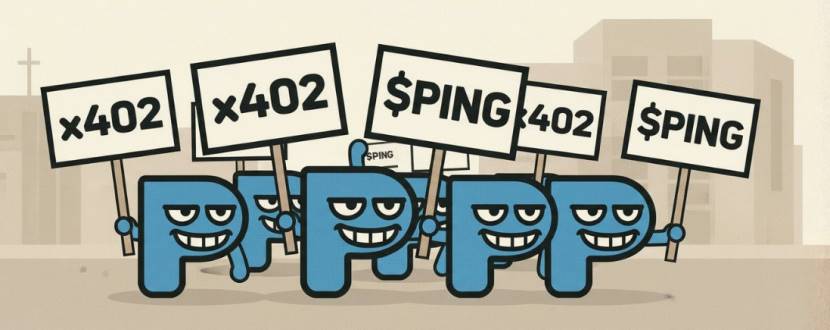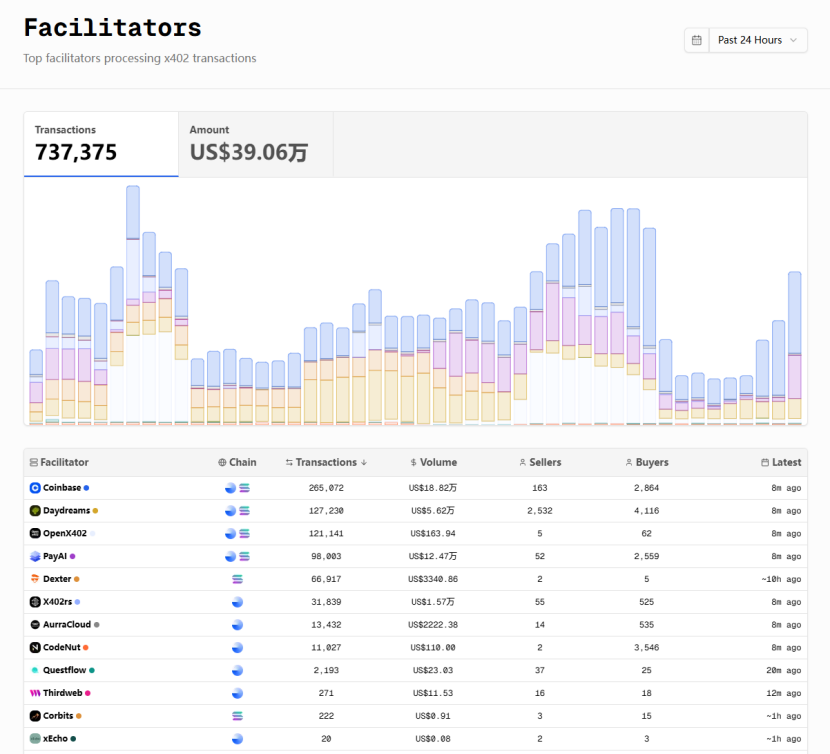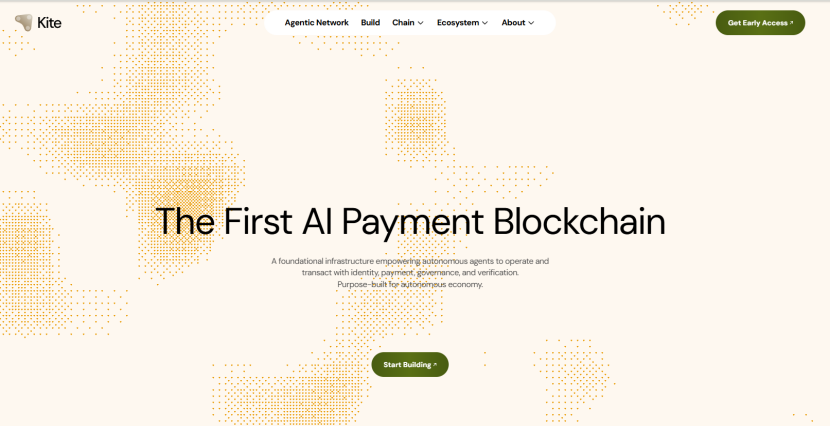The further development of AI will inevitably give rise to the demand for machine-to-machine trading and micropayments, and blockchain may be the ultimate infrastructure for AI and machine interaction.
Author: Trend Research
The recent emergence of $PING has driven the spread of the x402 concept, with two representative projects, $PING and $PAYAI, reaching highs of 75m and 70m respectively. Although both have retreated to 30m and 20m due to weak market liquidity, unlike pure meme narratives, x402 and its concept possess certain derivativeness and sustainability. The market still craves new narratives and opportunities for benefit, making the related narratives worth paying attention to.
I. Why x402 is Worth Attention
The biggest pain point in crypto development is the lack of projects that solve real-world problems, with a shortage of cash flow driven by genuine demand. x402 approaches from the logic of internet-native payments, and in the current context where stablecoins in the U.S. are beginning to be adopted by large institutions alongside further developments in AI, it is expected to start forming real payment demand from a small scale.
The driving forces and adopters behind x402 include Coinbase, Google, Cloudflare, Circle, Visa, and AWS, which together have a large customer base and consumption scenarios.
x402 can create user-perceptible use cases on the product side, such as enabling payments through digital wallets without the need to add bank cards or undergo KYC, and even allowing AI agents to complete an entire shopping process directly.
The further development of AI will inevitably give rise to the demand for machine-to-machine trading and micropayments, and blockchain may be the ultimate infrastructure for AI and machine interaction.
II. Deconstructing x402
402 is a status code in HTTP that has always been reserved but almost never used, representing "Payment Required." x402 will optimize and enable this code, and its structure is simple enough to be illustrated in one image.
A complete process for transactions using the x402 protocol involves four roles:
1. Client
The client refers to the party initiating the payment request. It can be any entity needing access to a service or resource, such as an AI agent, user device, or application. The main responsibilities of the client are:
- Initiating requests: The client requests access to a resource or service.
- Processing payments: When the server returns a payment requirement (HTTP 402), the client signs the payment request and executes the payment. The client can use tools like wallets to sign transactions and provide payment authorization.
Example: An AI agent needs to obtain real-time market data from a data provider. It acts as the client and initiates the request, receiving the data only after the payment is completed.
2. Server
The server is the party providing the service or resource. Its main responsibilities are:
- Returning HTTP 402 response: When the client requests access to a resource, if there is no valid payment information, the server returns the HTTP 402 status code, indicating that payment is required to continue access.
- Verifying payment and providing service: The server verifies the client's payment request to ensure that payment has been completed. If the payment is successful, the server processes and returns the requested data or service.
Example: An API service provider, upon receiving a client request, finds no payment and returns an HTTP 402 response requesting payment. After payment is completed, the service provider returns the data or service to the client.
3. Facilitator
The facilitator acts as an intermediary in the payment process, typically a payment gateway or intermediary service, ensuring that payment requests are smoothly transmitted and ultimately completed. The main functions of the facilitator are:
- Coordinating payment requests and responses: It handles the payment interactions between the client and server, ensuring that payment requests are correctly sent and forwarding payment information to the payment processor.
- Broadcasting transactions: The facilitator may broadcast payment requests or confirm transactions to the blockchain.
Example: In the payment process, the facilitator may be a wallet application or payment gateway that receives the client's payment request and broadcasts it to the blockchain for settlement after the transaction is successful.
4. Blockchain
The blockchain is the underlying technological foundation of the x402 process, ensuring the security and transparency of transactions. The core responsibilities of the blockchain include:
- Ensuring the immutability of payments: Once payment information is recorded on the blockchain, it cannot be modified or revoked, ensuring the authenticity and integrity of the transaction.
- Providing a transparent settlement system: All transaction data is publicly available on the chain, allowing all parties to verify payment status.
- Settlement and transaction processing: Once the facilitator confirms the payment, the blockchain processes and ultimately settles the transaction, ensuring that funds flow from the client to the server provider.
Example: When the client completes the payment, the payment request is transmitted through the facilitator to the blockchain, ensuring that the payment funds flow between the correct addresses to complete the settlement.

A process:
- The client sends an HTTP request - the client sends a standard HTTP request to the resource server to access a protected endpoint.
- The server responds with 402 - the resource server returns the HTTP 402 payment required status code and provides payment details in the response body.
- The client creates a payment - the client checks the payment requirements and creates a payment payload using its wallet according to the specified scheme.
- The client resubmits the payment - the client resends the same HTTP request, this time including a header with the X-PAYMENT signed payment payload.
- The server verifies the payment - the resource server verifies the payment payload by:
- Locally (if they run their own validation)
- Through intermediary services (recommended)
- Payment service provider verification - if using a payment service provider, it checks the payment according to the scheme and network requirements and returns a verification response.
- The server processes the request - if the payment is valid, the server completes the original request. If the payment is invalid, it returns another 402 response.
- Payment settlement - the server can initiate blockchain settlement in two ways:
- Directly by submitting to the blockchain
- Through the facilitator's /settle endpoint
- The payment processor submits an on-chain transaction - the payment processor broadcasts the transaction to the blockchain according to the payment network and waits for confirmation.
- Settlement confirmation - once confirmed on-chain, the settlement party returns a payment execution response.
- The server delivers the resource - the server returns a response containing:
- The requested resource in the response body
- The X-PAYMENT-RESPONSE header containing settlement details
In simple terms, x402 is an open payment standard that eliminates traditional barriers such as API keys, subscription models, and manual settlements, achieving an efficient, frictionless payment system, particularly suitable for machine-to-machine (M2M) or AI-driven application scenarios.
III. The Narrative is Brewing
Understanding the structure, it is not difficult to see that the emergence of new crypto projects may revolve around the client, server, facilitator, blockchain, and transaction processes. Currently, most servers are primarily provided by existing web2 resource parties, and the client has been hyped during the last wave of AI agent enthusiasm but lacks genuine routine demand. Recent focuses include Ping (around the transaction process), PayAI Network (facilitator), and Kite AI (blockchain).
1. Ping
Ping is the first token to complete minting/distribution using the x402 protocol. The market compares it to inscriptions, as users send USDC to a specific address on the Base chain, which is just a regular ERC-20 transfer. The project team acts as an "indexer" through x402scan, giving it off-chain meaning, "sending USDC to a specified address via the x402 protocol is minting, rewarding the address that initiated the transaction."
Although Ping itself does not have much practical demand significance, the chosen angle is quite clever. Currently, it is the first meme coin to break the mold of the x402 concept.

2. PayAI Network
Positioned as the x402 facilitator (matching/settlement/verification/settlement layer), focusing on Solana first and cross-chain. Compared to Ping, it has actual use cases, with similar projects like Daydreams and OpenX402, with the core still being the facilitator provided by Coinbase.

3. Kite AI
Positioned as the "first public chain for AI payments," aiming to write x402 payment primitives "into the underlying layer," focusing on settlement/reconciliation/intention execution between agents and services. It uses x402 as an interoperability layer: agents initiate payments through standardized intention/authorization envelopes, and service providers verify terms and settle; it natively supports reconciliation, peer instructions, batch aggregation, and other payment primitives. The investor lineup is impressive, including PayPal Ventures, Coinbase Ventures, Hashed, Samsung Next, HashKey Capital, and others.

Looking back, traditional companies like Coinbase began launching x402 as early as May and are currently accelerating development. Coinbase CEO Brian Armstrong stated on November 2, "x402 will allow stablecoin payments to be attached to any web request, which will become an important part of the new internet."
Currently:
- Visa supports the x402 standard, participating in support and standardization, promoting the development of x402 in traditional payment networks, seen as a signal for future large-scale adoption.
- Cloudflare and Coinbase jointly created the x402 Foundation, providing technical support and expansion proposals.
- Anthropic supports the x402 protocol for AI and infrastructure payments.
- Circle is developing integration tools to combine USDC and wallets with x402.
- Google is laying out the x402 protocol, participating in related investment and development opportunities.
- AWS supports the x402 protocol for AI and infrastructure payments.
Although the heat around x402 concept projects has cooled somewhat, this brief market surge has shown the demand for technological micro-innovation and real use cases.
On one hand, there is the underlying technology development and self-adoption by traditional tech and financial companies, and on the other hand, the successive emergence of crypto projects. A new narrative around AI and payments is visibly heating up.
免责声明:本文章仅代表作者个人观点,不代表本平台的立场和观点。本文章仅供信息分享,不构成对任何人的任何投资建议。用户与作者之间的任何争议,与本平台无关。如网页中刊载的文章或图片涉及侵权,请提供相关的权利证明和身份证明发送邮件到support@aicoin.com,本平台相关工作人员将会进行核查。




